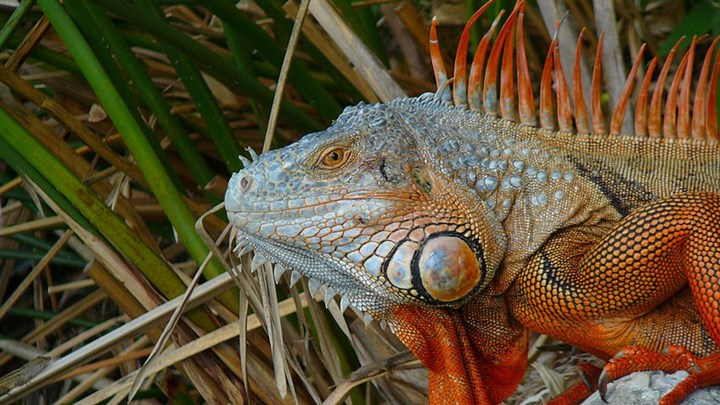
by Brian McCombie - Friday, July 12, 2019

While the destruction certainly hasn’t reach Godzilla-like proportions, another big lizard is creating all sorts of havoc in south and central Florida: the green iguana. So much so, the Florida Fish and Wildlife Commission (FWC) recently posted a directive on the agency’s website asking people to hunt the scaly critters.
“Green iguanas are not native to Florida and are considered to be an invasive species due to the damage they can cause to seawalls, sidewalks, and landscape plants,” the FWC directive read. “This species is not protected in Florida except by anti-cruelty law. Homeowners do not need a permit to kill iguanas on their own property, and the FWC encourages homeowners to kill green iguanas on their own property whenever possible. Iguanas can also be killed year-round and without a permit on 22 public lands in south Florida.”
According to USA Today, the burgeoning iguana populations “apparently began as escaped pets or otherwise managed to slip into the region from their native Central and South America, finding South Florida's man-made canals perfect for colonizing. North Florida is a bit too cold, however, so no issue there.”
The article continued, “They get big. Male green iguanas can grow to over 5 feet in length and weigh up to 17 pounds. Females reach lengths similar to those of males, but usually do not exceed 7 pounds. They live about a decade in the wild and can last twice that long in captivity.”
As HLF reported in the past, Florida has become a regular smorgasbord of destructive and dangerous exotic and invasive wildlife, including the Burmese python, another species state officials have encouraged people to hunt.
Like so many invasive species, the green iguanas are also very prolific. According to FWC, females need to be between 2- to 4-years-old before they can breed, but once they reach breeding age, they will lay eggs in clutches of between 14 and 76 eggs. That’s right—a single breeding female can lay up to 76 eggs per annual breeding cycle! (Both sexes will also show an orange color during mating season, though it might be less intense in a female.)
Jon Draper knows iguanas. Executive editor of the NRA’s own American Hunter magazine, Draper was on an iguana hunt a few years ago in Puerto Rico, hosted by air-rifle manufacturer HATSAN USA. He bagged a good number of the lizards and wrote up the experience for the magazine. He also saw the problems these big critters can cause.
“As for damage I witnessed, we got a firsthand look at a small, family-owned farm, with a garden out front completely destroyed by burrows and hungry iguanas,” Draper told NRAHLF.org. “All that remained of the once lush, producing garden was sand and gravel, and a large tree nearby where we counted over 50 iguanas basking in the sun. The large den they'd dug in the garden was still in use, with countless remnants of eggshells from constant breeding strewn about.”
Draper continued, “As for hunting? While I had a blast with the HATSAN air rifles, oh the fun it would be to go after them with a .22LR or a 20-gauge shotgun. Any squirrel killer will do—just make sure to shoot them in the head. My suggestion to Florida: Open season with a $1 per-tail bounty!”
Iguanas are also pretty fine eating. Draper dined on iguana in Puerto Rico and thought they tasted excellent. “Puerto Rican culture hasn't warmed up to them as table fare the way they have in South America, but with some decent recipes they can be delicious. They taste like, yes, chicken.”
About the Author:
Brian McCombie is a field editor and editorial contributor for the NRA's American Hunter. He writes about firearms and gear for the NRA's Shooting Illustrated website, as well as handling public relations and marketing for companies and manufacturers in the shooting sports industry. He is a member of the National Rifle Association and the National Shooting Sports Foundation. Brian likes hunting hogs, shooting 1911s chambered in 10 mm and .45 ACP, watching the Chicago Bears and relaxing with Squinchy, the orange tabby cat.
Follow NRA Hunters' Leadership Forum on Twitter @HuntersLead.
E-mail your comments/questions about this site to:
[email protected]
